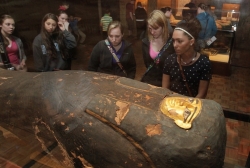ABOUT US
FIND YOUR EGYPT TRIP
Find best priced trips in Egypt..
Egypt Travel Blog
Mummies' World
05/01/2011
A mummy is the body of a person (or an animal) that has been preserved after death. Normally when we die, bacteria and other germs eat away at the soft tissues (such as skin and muscles) leaving only the bones behind. Since bacteria need water in order to grow, mummification usually happens if the body dries out quickly after death. The body may then be so well preserved that we can even tell how the dead person may have looked in life. Mummies are made naturally or by embalming, which is any process that people use to help preserve a dead body. Mummies can be dried out by extreme cold, by the sun, by smoke, or using chemicals such as natron. Some bodies become mummies because there were favorable natural conditions when they died. Others were preserved and buried with great care. The ancient Egyptians believed that mummifying a person's body after death was essential to ensure a safe passage to the afterlife. Mummification in ancient Egypt was a very long and expensive process. From start to finish, it took about seventy days to embalm a body. Since the Egyptians believed that mummification was essential for passage to the afterlife, people were mummified and buried as well as they could possibly afford. High-ranking officials, priests and other nobles who had served the pharaoh and his queen had fairly elaborate burials. The pharaohs, who were believed to become gods when they died, had the most magnificent burials of all. In the case of a royal or noble burial, the embalmers set up workshops near the tomb of the mummy. The art of Egyptian mummification consisted of many steps. First, the body was washed and ritually purified. The next step was to remove the deceased person's inner organs. A slit was cut into the left side of the body so that the embalmers could remove the intestines, the liver, the stomach and the lungs. Each of these organs was embalmed using natron, which served to dry out the organs and discourage bacteria from decaying the tissues. The organs were then individually wrapped using long strips of linen and placed in canopic jars. The lids of these jars were fashioned after the four sons of Horus, who were each entrusted with protecting a particular organ. Many of the pharaohs can be visited in the Cairo Museum, but the mummies of many others have not been identified. Around three thousand years ago, Egypt suffered from invasions and civil war. During that time, the Valley of the Kings was devastated by robbers, and by bureaucrats, anxious to recycle the golden treasures of the past to pay the expenses of the current kings. At this time, royal mummies were shifted from place to place and from coffin to coffin, often ending up, denuded of their jewels and fine wrappings, damaged, in the reused coffins of commoners. Could the mysterious mummy of Niagara Falls have suffered such a fate? Several things suggested that the mummy was regal. First, his hands were crossed over his chest; now empty, they had once held objects. Could those objects have been the crook and flail of kingship? Second, the mummy had always been associated with a good quality coffin of the late XVIII or early XIX dynasty; such coffins had been used by the Ancient Egyptian scribe Butehamun and his colleagues. When they had separated the royal dead from their treasures, they stored the bodies in recycled mummy cases, in the safety of secret tombs. Two of these hiding places of the Kings were found in the last century ¬ but not all of the kings were accounted for. And finally, that noble face! The Niagara Falls gentleman resembles not so much the famous Nefertiti, as the Ramesside kings of the XX Dynasty. Could this mummy have been one of them? The bodies Of Ramesses VIII, X, and XI are among the missing. Before any identification can be made, however, scientific evidence must be considered. How old are the mummies of Niagara Falls ? Do they date back to the times of the Pharaohs, or were they people who died during the Roman occupation of Egypt, or even later? Unscrupulous dealers have been known to place the bodies of folks who died only a few hundred years ago into ancient coffins. Expert radiologists came to Canada to examine the evidence. Dr. Wolfgang Pahl and his assistant Lisa Bark from Tubingen joined Dr. Eggebrecht. State-of-the-art technology was called in too, and the prototype of a mobile x-ray machine by Siemens was flown in. Jacob Sherman, the director of the Museum, gave every co-operation. Galleries were closed so that the mummies could be studied, some still in their coffins, too fragile to be moved. The handsome gentleman who was not Nefertiti was now called Niagara Falls Mummy Number Five ¬ NFM 5 . The ancient body was subjected to many tests. The interior of the body was examined by endoscope, and showed that the man had indeed been mummified. Lateral x-rays of the skull show material remaining in the occiput from the mummification process. Pahl and Eggebrecht agreed that this would be consistent with a date in the XIX or XX Dynasty. The body was measured ¬ 1.54 cm, (five foot five and a half, ) about the same height as King Tutankhamun. This is a little taller than the average ancient Egyptian, but it is the usual pattern for well-fed members of the ruling class. Back in Germany, Dr. Eggebrecht, in consultation with Dr. Pahl and his team, continued the study of the x-rays and tissue samples, not only of NFM 5, but of the other Niagara Falls mummies as well. Many factors were considered in assigning the bodies to approximate time periods. The mummy of one woman, who lived about two thousand, six hundred years ago, may well be the original inhabitant of the most beautiful of the Niagara Falls coffins; she still wears her hair in the braided style of the XXVI Dynasty. Most of the mummies, however, appear to be people who lived in Roman times. The physiological information and dates used on this website are those suggested by Dr. Eggebrecht and Dr. Pahl in their report. This report is available, in German, upon request. [The reports on NFM 4 and 5 are available in English.] Since the investigations of the mid 1980s, new techniques, such as DNA analysis have become available for the study of the ancient dead. No longer is the burning question whether a mummy can be identified as a particular historical character. We want to know about the way people lived in the past. Were they healthy? What parasites did they suffer from? What chemicals were in their environment? Did they suffer from industrial pollution? But the Mysterious Mummy is still unidentified. Who was Niagara Falls M 5? C-14 studies were later conducted by Patrick Horne . The Regal Gentleman seems to have lived about three thousand years ago. This mummy could indeed belong to the XX Dynasty ¬ at least the time period, if not the royal family. DNA analysis will be required to know if there is indeed any link between this man of Ancient Times, and the Warrior Kings of the late New Kingdom. National Geographic Television chose the Niagara Falls Museum's collection of Egyptian mummies to be included in a special documentary about the practices of ancient Egyptian mummification, titled "Mr. Mummy."


